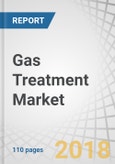The gas treatment market is projected to register a CAGR of 5.7%, from 2018 to 2023, in terms of value.
Non-amines to be the fastest-growing type of gas treatment, during the forecast period, in terms of volume and value
Non-amines is projected to be the fastest-growing type segment during the forecast period, in terms of value and volume. These chemicals remove the water content from natural gas streams and help in preventing hydrate formation. Triethylene glycol is the largest non-amine used for dehydration and hydrate removal or prevention.
APAC gas treatment market is projected to register the highest CAGR during the forecast period, in terms of volume
Discovery of new gas fields, especially in APAC is the major factor driving the consumption of gas treatment. The recent discovery of new gas fields in the region will boost the demand for gas treatment. In March 2018, the Department of Energy (US) had declared the Alegria Oil Field in Cebu (the Philippines) to have commercial quantities of natural gas. The resource has about 9.42 billion cubic feet of natural gas. In Bhola district of Bangladesh, explorers have found 600 billion cubic feet of gas. All these new gas field explorations are expected to increase the consumption of gas treatment in these regions during the forecast period.
The market sizes estimated in this study have been validated through primary interviews conducted with various industry experts, globally.
These primary sources have been divided into three categories:
- By Company Type: Tier I - 25%, Tier II - 50%, and Tier III - 25%
- By Designation: C Level - 20%, Director Level - 30%, and Others - 50%
- By Region: North America - 20%, Europe - 30%, APAC - 25%, South America - 15%, and the Middle East, CIS & Africa - 10%
Research Coverage
The objective of this study is to define, describe, and forecast the gas treatment market based on various segmentations and strategically analyze these market segments with respect to individual growth trends, growth prospects, and contribution to the overall gas treatment market. In this report, the market has been segmented based on type, application, and region.
Reasons to Buy the Report
The report is expected to help market leaders/new entrants in the gas treatment market in the following ways:
- This report comprehensively segments the gas treatment market and provides the closest approximations for the sizes of different segments and subsegments of the market across different verticals and regions.
- This report is expected to help stakeholders in obtaining an improved understanding of their competitors and gain insights about their businesses. The competitive landscape section includes detailed information about new product launches, investments & expansions, and agreements that have been undertaken by various key players to enhance their position in the gas treatment market
Table of Contents
Companies Mentioned
- Huntsman International LLC
- BASF SE
- Dowdupont Inc.
- Ecolab Inc.
- Berryman Chemicals Inc.
- Clariant International Ltd.
- Eunisell Chemicals
- Hexion Inc.
- Innospec Inc.
- Varichem International
- Advance Petrochemicals Ltd.
- Akzonobel N.V.
- Amine & Plasticizers Limited
- Baker Hughes Inc.
- Baze Chemical
- Doorf Ketal Chemicals
- Exxon Mobil Corporation
- Mcc Chemicals, Inc.
- Production Chemical Group
- Sintez Oka Group of Companies
Table Information
| Report Attribute | Details |
|---|---|
| No. of Pages | 110 |
| Published | October 2018 |
| Forecast Period | 2018 - 2023 |
| Estimated Market Value ( USD | $ 3.76 billion |
| Forecasted Market Value ( USD | $ 4.96 billion |
| Compound Annual Growth Rate | 5.7% |
| Regions Covered | Global |
| No. of Companies Mentioned | 20 |









